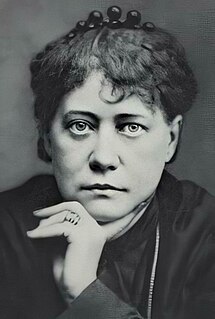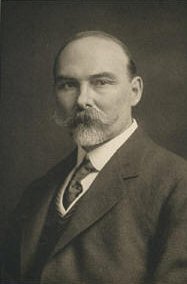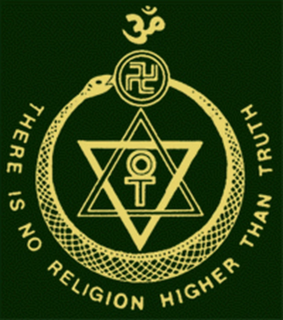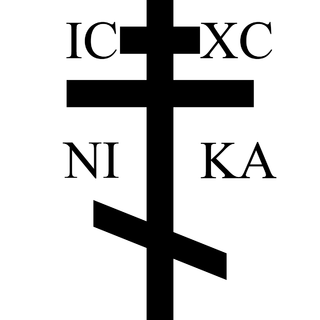Kenneth Paul Johnson (born 1953) is a retired public library director from southern Virginia, and a writer on modern Western esotericism as well as North Carolina history.
Kenneth Paul Johnson (born 1953) is a retired public library director from southern Virginia, and a writer on modern Western esotericism as well as North Carolina history.
Mahātmā is an honorific used in India.

Helena Petrovna Blavatsky was a Russian author who co-founded the Theosophical Society in 1875. She gained an international following as the leading theoretician of Theosophy.

Alfred Percy Sinnett was an English author and theosophist.

Isis Unveiled: A Master-Key to the Mysteries of Ancient and Modern Science and Theology, published in 1877, is a book of esoteric philosophy and Helena Petrovna Blavatsky's first major work and a key text in her Theosophical movement.

Morya is one of the "Masters of the Ancient Wisdom" within modern Theosophical beliefs. He is believed to be one of the Mahatmas who inspired the founding of the Theosophical Society and was engaged in a correspondence with two English Theosophists living in India, A. P. Sinnett and A. O. Hume. The correspondence was published in 1923 by A. Trevor Barker, in the book The Mahatma Letters to A. P. Sinnett.
Gina Cerminara was an American author in the fields of parapsychology, spirituality and reincarnation. She was born in Milwaukee and received BA, MA, and Ph.D. degrees in psychology from the University of Wisconsin–Madison. Her years of research regarding Edgar Cayce led her to publish a book about reincarnation in 1950 titled Many Mansions. Her other books on reincarnation include The World Within, Many Lives, Many Loves and Insights for the Age of Aquarius.

George Robert Stow Mead was an English historian, writer, editor, translator, and an influential member of the Theosophical Society, as well as the founder of the Quest Society. His scholarly works dealt mainly with the Hermetic and Gnostic religions of Late Antiquity, and were exhaustive for the time period.

The Mahatma Letters to A.P. Sinnett is a book published in 1923 by A. Trevor Barker. (ISBN 1-55700-086-7) According to Theosophical teachings, the letters were written between 1880 and 1884 by Koot Hoomi and Morya to A. P. Sinnett. The letters were previously quoted in several theosophical books, but not published in full. The letters were important to the movement due to their discussions on the theosophical cosmos and spiritual hierarchy. From 1939, the original letters were in the possession of the British Museum but later the British Library.

Theosophical teachings have borrowed some concepts and terms from Buddhism. Some theosophists like Helena Blavatsky, Helena Roerich and Henry Steel Olcott also became Buddhists. Henry Steel Olcott helped shape the design of the Buddhist flag. Tibetan Buddhism was popularised in the West at first mainly by Theosophists including Evans-Wentz and Alexandra David-Neel.
The Master Hilarion is considered a saint within the I AM movement, one of the "Masters of the Ancient Wisdom", and in the Ascended Master Teachings is one of the Ascended Masters. He is considered to be the Chohan (Lord) of the Fifth Ray.

Serapis Bey, sometimes written as Serapis, is regarded in Theosophy as one of the Masters of the Ancient Wisdom; and in the Ascended Master Teachings is considered to be an Ascended Master and member of the Great White Brotherhood. He is regarded as the Chohan of the Fourth Ray. C. W. Leadbeater wrote that Henry Steel Olcott was given occult training by Serapis Bey when his own master, Morya, was unavailable. A series of letters to Olcott, alleged to be from Serapis, encouraging Olcott to support Blavatsky in the founding of the Theosophical Society were published in the book Letters from the Masters of the Wisdom.
Paul the Venetian or the Venetian Chohan is one of the "Masters of the Ancient Wisdom" in the teachings of Theosophy and is regarded as one of the ascended masters in the Ascended Master Teachings. He is regarded as the Master of the Third Ray. According to the Church Universal and Triumphant, his final life was his incarnation as the artist Paolo Veronese (1528-1588), after which he is said to have become an Ascended Master.
The Great White Brotherhood, in belief systems akin to Theosophy and New Age, are said to be perfected beings of great power who spread spiritual teachings through selected humans. The members of the Brotherhood may be known as the Masters of the Ancient Wisdom, the Ascended Masters, the Church Invisible, or simply as the Hierarchy. The first person to talk about them in the West was Helena Petrovna Blavatsky (Theosophy), after she and other people claimed to have received messages from them. These included Helena Roerich, Aleister Crowley, Alice A. Bailey, Guy Ballard, Geraldine Innocente, Elizabeth Clare Prophet, Bob Sanders, and Benjamin Creme.

The Masters of the Ancient Wisdom are claimed to be enlightened beings originally identified by the Theosophists Helena Blavatsky, Henry S. Olcott, Alfred Percy Sinnett, and others. These Theosophists claimed to have met some of The Masters during their lifetimes in different parts of the world. Sometimes they are referred to by Theosophists as Elder Brothers of the Human Race, Adepts, Mahatmas, or simply as The Masters.

Count Saint Germain is a legendary spiritual master of the ancient wisdom in various Theosophical and post-Theosophical teachings, said to be responsible for the New Age culture of the Age of Aquarius and identified with the Count Saint Germain, who has been variously described as a courtier, adventurer, inventor, alchemist, pianist, violinist, and amateur composer.

Man: Whence, How and Whither, A Record of Clairvoyant Investigation, published in 1913, is a theosophical book compiled by the second president of the Theosophical Society (TS) - Adyar, Annie Besant, and by a TS member, Charles W. Leadbeater. The book is a study on early times on planetary chains, beginnings of early root races, early civilizations and empires, and past lives of men.

Theosophy is a religion established in the United States during the late 19th century. It was founded primarily by the Russian immigrant Helena Blavatsky and draws its teachings predominantly from Blavatsky's writings. Categorized by scholars of religion as both a new religious movement and as part of the occultist stream of Western esotericism, it draws upon both older European philosophies such as Neoplatonism and Asian religions such as Hinduism and Buddhism.

Christianity and Theosophy, for more than a hundred years, have had a "complex and sometimes troubled" relationship. The Christian faith was the native religion of the great majority of Western Theosophists, but many came to Theosophy through a process of opposition to Christianity. According to professor Robert S. Ellwood, "the whole matter has been a divisive issue within Theosophy."

"What Is Theosophy?" is an editorial published in October 1879 in the Theosophical magazine The Theosophist. It was compiled by Helena Blavatsky and included into the 2nd volume of the Blavatsky Collected Writings. According to a doctoral thesis by Tim Rudbøg, in this "important" article Blavatsky "began conceptualizing her idea of 'Theosophy'."

Hinduism is regarded by modern Theosophy as one of the main sources of "esoteric wisdom" of the East. The Theosophical Society was created in a hope that Asian philosophical-religious ideas "could be integrated into a grand religious synthesis." Prof. Antoine Faivre wrote that "by its content and its inspiration" the Theosophical Society is greatly dependent on Eastern traditions, "especially Hindu; in this, it well reflects the cultural climate in which it was born." A Russian Indologist Alexander Senkevich noted that the concept of Helena Blavatsky's Theosophy was based on Hinduism. According to Encyclopedia of Hinduism, "Theosophy is basically a Western esoteric teaching, but it resonated with Hinduism at a variety of points."